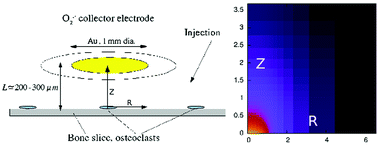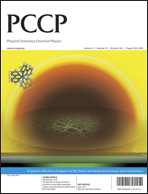We report simulations of electrochemical generation–collection experiments in which the generator is a small disc producing a specified time-dependent flux of the analyte and the collector is a large planar electrode which collects the analyte at the mass transport-controlled rate. This geometry corresponds to many experiments in bioelectrochemistry where a relatively large sensor is used to detect the products of a cell's metabolism at low concentration. In particular, our simulations are motivated by attempts to understand our results on the detection of the superoxide radical anion burst generated by osteoclasts (bone-resorbing cells) in response to various stimuli. Superoxide is present at low levels and disproportionates in aqueous media; however, the homogeneous kinetics are included in our simulations and the results show that it is possible to estimate the magnitude of the flux of superoxide produced by the cells and to accurately determine the time-dependence of the flux in response to stimuli such as injection of parathyroid hormone, vitamin D3 and pertussis toxin. In all these cases, the superoxide anion flux was successfully modeled as uniform across the cell surface with time-dependence of the form j0e−kdt + j∞. j∞ is the sustained flux of superoxide and the first-order rate constant kd and the magnitude j0 describe the transient component of the flux. The simulations indicate that for cell–electrode gaps  , where D is the diffusion coefficient, the value of kd can be accurately extracted from the time-dependence of the collector current without detailed knowledge of parameters which are hard to measure during the experiment, e.g., the cell radius a and cell–electrode separation d. In the case of parathyroid hormone, the first-order rate constant describing the decay of the transient component was kd = 1.8 ± 0.8 × 10−1 s−1, but much slower decays were observed in response to pertussis toxin (kd = 1.5 ± 0.5 × 10−2 s−1) and vitamin D3 (kd = 1.1 ± 0.5 × 10−3 s−1).
, where D is the diffusion coefficient, the value of kd can be accurately extracted from the time-dependence of the collector current without detailed knowledge of parameters which are hard to measure during the experiment, e.g., the cell radius a and cell–electrode separation d. In the case of parathyroid hormone, the first-order rate constant describing the decay of the transient component was kd = 1.8 ± 0.8 × 10−1 s−1, but much slower decays were observed in response to pertussis toxin (kd = 1.5 ± 0.5 × 10−2 s−1) and vitamin D3 (kd = 1.1 ± 0.5 × 10−3 s−1).

This article is Open Access
 Please wait while we load your content...
Something went wrong. Try again?
Please wait while we load your content...
Something went wrong. Try again?
 , where D is the diffusion coefficient, the value of kd can be accurately extracted from the time-dependence of the collector current without detailed knowledge of parameters which are hard to measure during the experiment, e.g., the cell radius a and cell–electrode separation d. In the case of parathyroid
, where D is the diffusion coefficient, the value of kd can be accurately extracted from the time-dependence of the collector current without detailed knowledge of parameters which are hard to measure during the experiment, e.g., the cell radius a and cell–electrode separation d. In the case of parathyroid 

 Please wait while we load your content...
Please wait while we load your content...